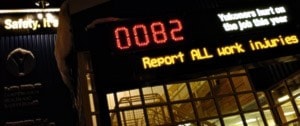In 2006, the Yukon saw the highest number of reported injuries in 13 years: 1,984 workers were hurt on the job and three died.
So far, in 2007, there have been 82 injuries.
With more than two reports per day, this year is on track to exceed the 2006 figure.
So why is the number of reported injuries in the territory so high?
It’s a million-dollar question, without an easy answer, say industry experts.
Factors like better reporting of injuries, the Yukon’s expanding workforce and the territory’s staff shortage, which is pushing more untrained workers into high-pressure jobs, are all having an impact.
What is an injury?
Compensable injuries include more than the average cut, burn or broken bone, said Yukon Workers’ Compensation Health and Safety Board president Valerie Royle.
Workers’ compensation defines an injury as “a work-related incapacity as determined by the board.”
It could be anything from post-traumatic stress disorder to an occupational disease such as carpal tunnel syndrome among office workers or radiation sickness among radiographers.
A “significant number,” but not a majority, of the injuries reported in 2007 have been related to slips and falls, said workers’ compensation spokesperson Mark Hill.
To qualify as a claim, an injury must fit two criteria.
First, it must require medical attention beyond the workplace.
“If you have to go to a doctor, you have to report it,” said Royle.
“Doctors, by law, have to report anything that may be a work injury to us.”
And second, it must require the worker to take time off the job.
Of course, there are some injury reports that stray into the realm of the ridiculous, but not many, said Royle.
“We’ve had two reports of paper cuts in 15 years,” she said.
Both reports were duly ignored, she added.
More workers are reporting injuries
The number on the scoreboard outside workers’ compensation’s Fourth Avenue office tallies the number of reported injuries.
Not every injury report becomes a claim, and not every claim is accepted and paid out, said Royle.
“And hooray,” she added. “That’s good because if we don’t know what the injury is, we can’t fix it.
“The hazards still exist, so that means one day someone’s going to get really hurt, and you can’t hide the really bad ones.”
An untrained and
expanding workforce
The Yukon has seen its lowest unemployment rates in years, which may be throwing more workers into jobs without the proper safety training, said Whitehorse Chamber of Commerce president Rick Karp.
“People are hiring whoever they can hire and getting them on the floor as quickly as possible.”
Also in the lead-up to the Canada Winter Games and other events people are busy, which means they may rush through things without thinking, he said.
“Often people are working short staffed and they’re working longer hours,” said Royle.
Although the labour shortage may be contributing to accident rates, it’s not a good explanation, said Yukon Federation of Labour president Alex Furlong.
“There is no excuse to rush someone into a job because you run the risk of them not going home that day.
“And that’s not an excuse anybody should be falling behind,” said Furlong.
Rising workers’
compensation rates
Along with a rising number of reported injuries, many Yukon businesses saw a hefty increase in their workers’ compensation rates in 2007.
But the two numbers are not necessarily connected, said Royle.
“The number of claims doesn’t make a hill of beans of difference to the rates,” said Royle.
The length of time claims are paid out affects costs more than the number of claims, said Royle.
The longer workers are off the job, the more salary workers’ compensation must cover.
Severity of the injury also has an impact on the costs and rates.
“I could have 300 claims and the total cost of all of them could be $10,000, and then I could have one that costs $1 million,” she said.
“If rates continue to increase it will become a huge burden to the employer financially,” said Karp.
High rates make it difficult for small businesses to survive in a competitive environment.
And they can deter new businesses from wanting to set up shop in the territory, said Karp.
Prevention
The No. 1 solution to rising injury rates is prevention, according to both labour and business groups.
“It’s been a terrible year,” said Furlong. “It’s a sign that both employers and employees need to pay more attention to injuries or accidents at work because they are all preventable.
“Quite often, people blame one side or the other,” said Furlong.
In 2006, Yukon workers’ compensation spent $400,000 on prevention campaigns.
It plans to spend another $500,000 in 2007.
Meanwhile, the Whitehorse Chamber of Commerce is offering a free service that sends a safety specialist to local businesses big and small, according to Karp.
“Are workplaces getting safer? No,” said Royle.
“I don’t think we’ve made any great improvements in workplace safety, yet.
“But we’re getting all of our stars aligned.”
